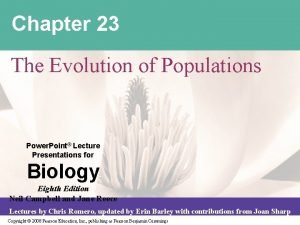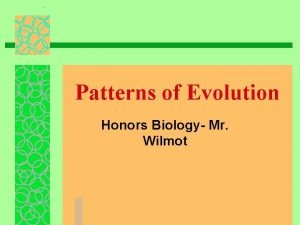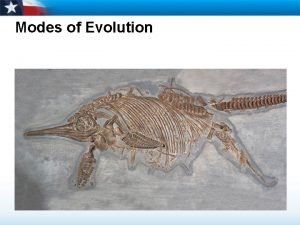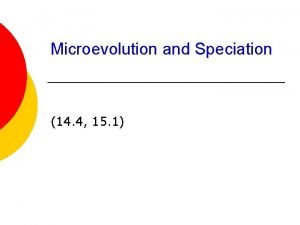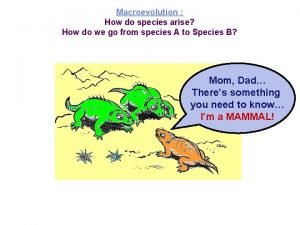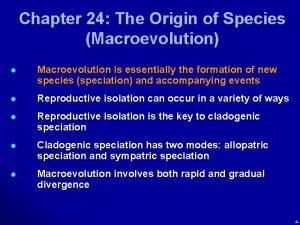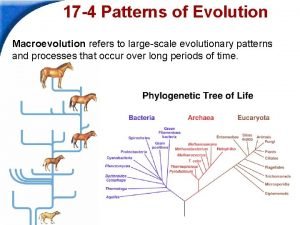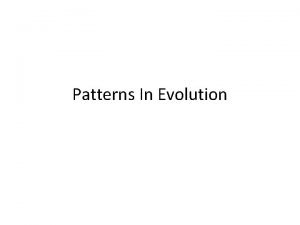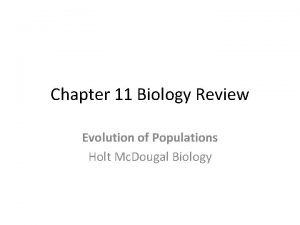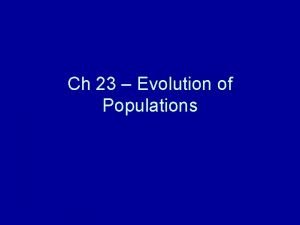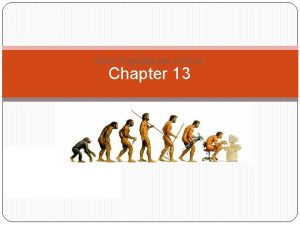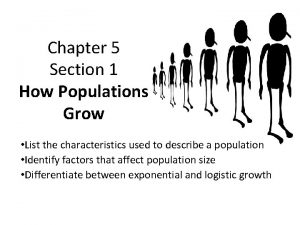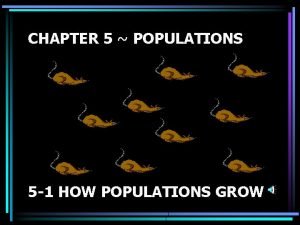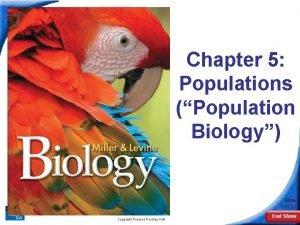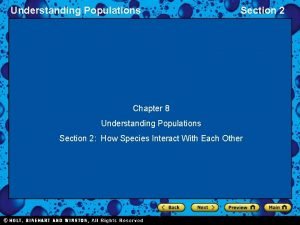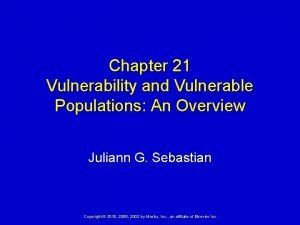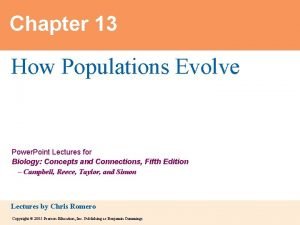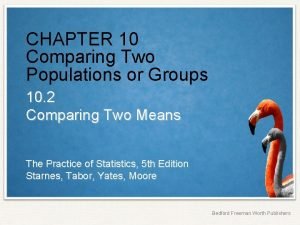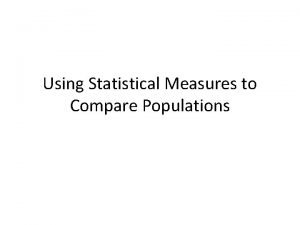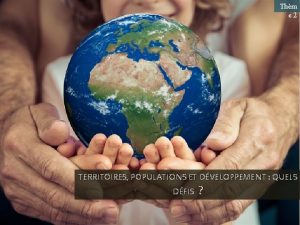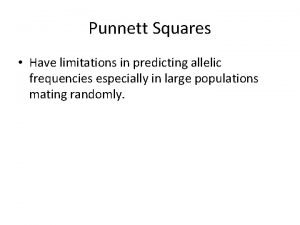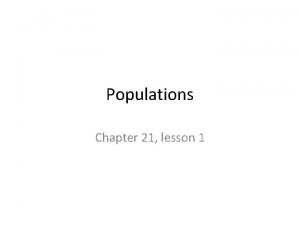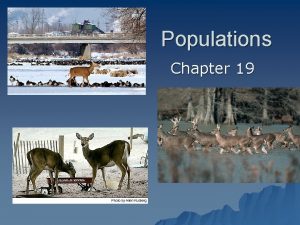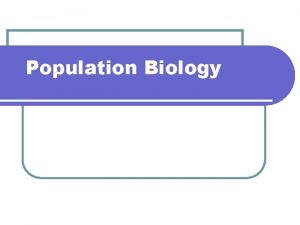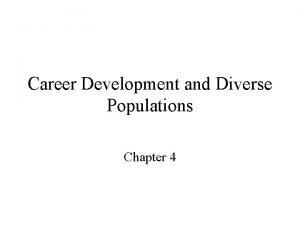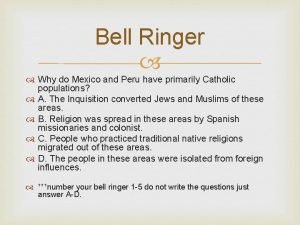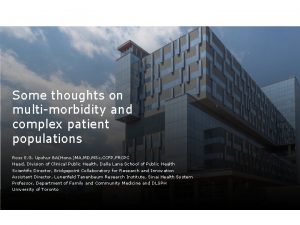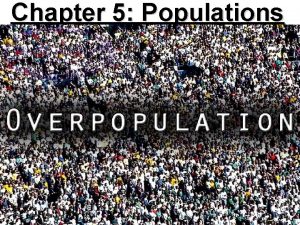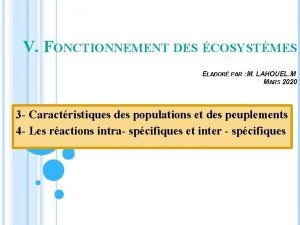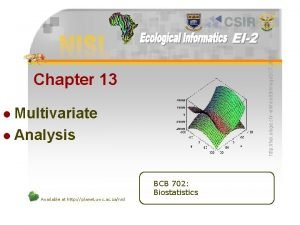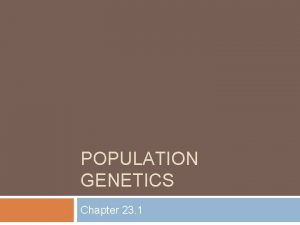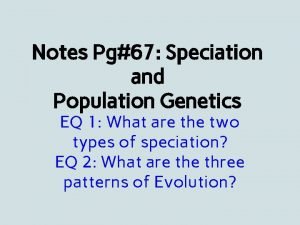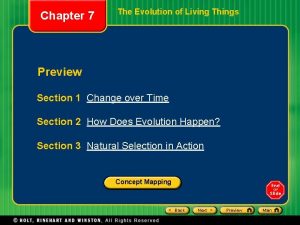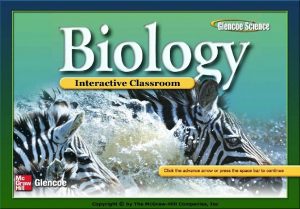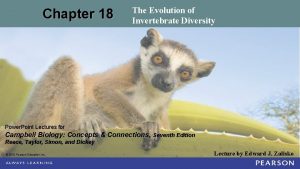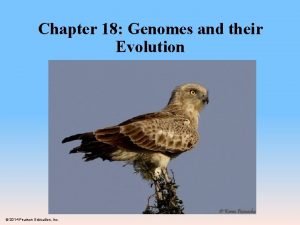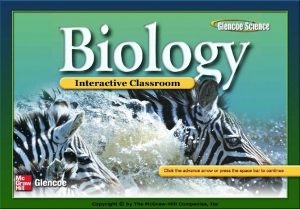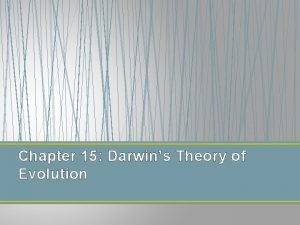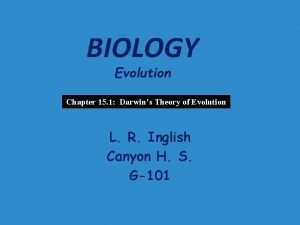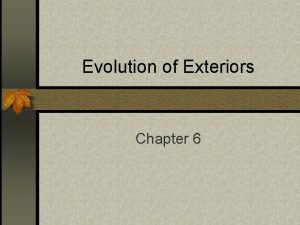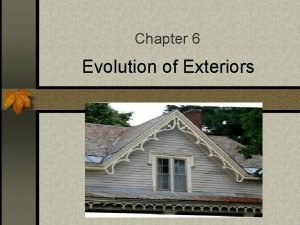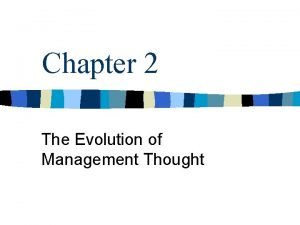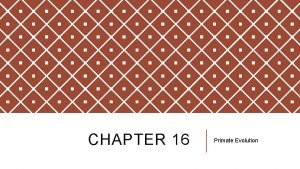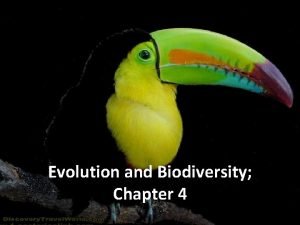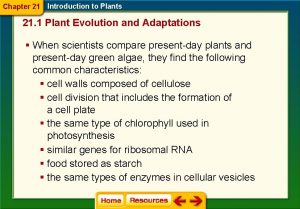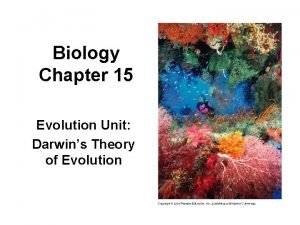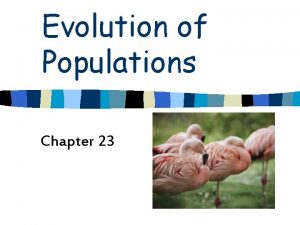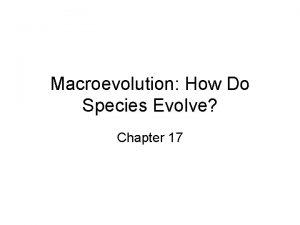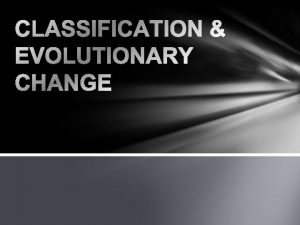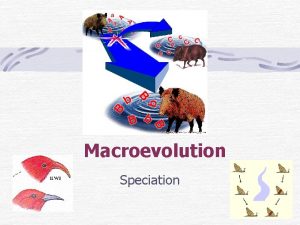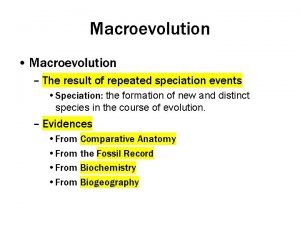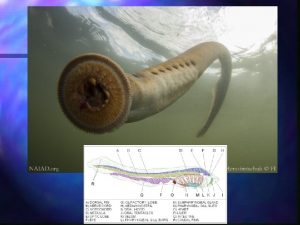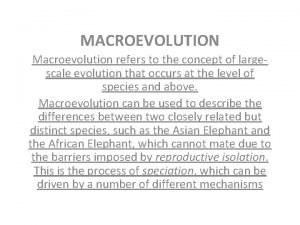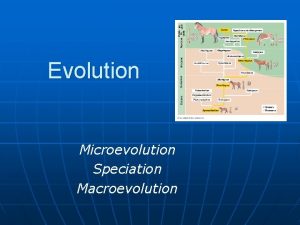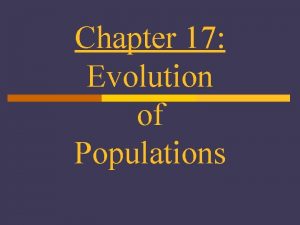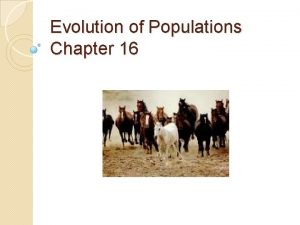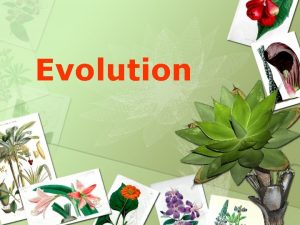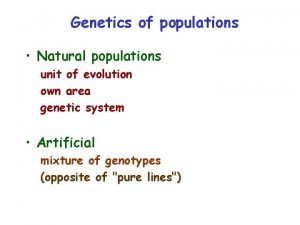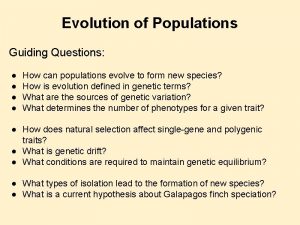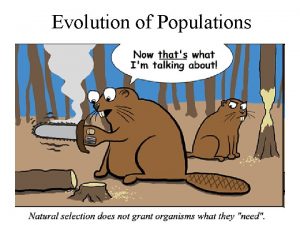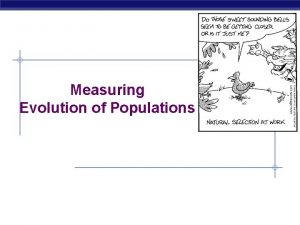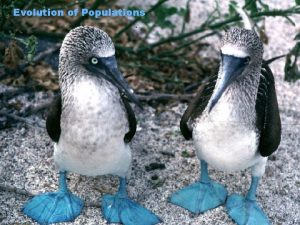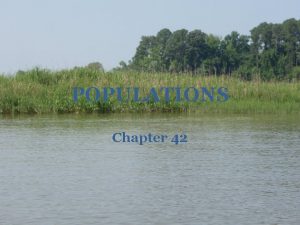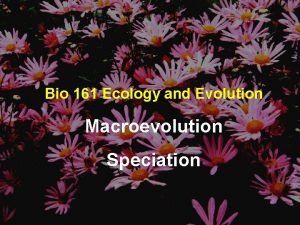Evolution of Populations Chapter 23 Macroevolution n Evolution
































































- Slides: 64

Evolution of Populations Chapter 23

Macroevolution n Evolution on a large scale n Changes in plants & animals n Where new forms replace old n Major episodes of extinction

Microevolution n Changes within a population n Changes in allele frequencies n Leads to adaptation of an organism

Variation n Gene variation n Driving force behind evolution n New genes & alleles can arise by mutation or gene duplication n Sexual reproduction


Genetic Variation from Sexual Recombination

Population genetics n Study of the properties of genes in populations

Population n Group of individuals n Same species n Interbreed n Fertile offspring

Population n Contains a great deal of variation n Variation-raw material for evolution

Gene pool n All the alleles n Of all individuals within a population

Hardy-Weinberg Principle n Determines if population is evolving n Frequencies of alleles in population n Used for baseline of genes in a population

Hardy-Weinberg n Equilibrium n When proportions of genotypes remain the same n Generation to generation

Hardy-Weinberg n Original proportions of genotypes in a population remain constant if n 1. Large population n 2. Random mating n 3. No mutations n 4. No gene flow n 5. No natural selection

Hardy-Weinberg n P+q=1 alleles n p=dominant n q=recessive n p 2 + 2 pq + q 2 = 1 genotypes

Hardy-Weinberg n 84 black 16 white (100 total)

Hardy-Weinberg n p 2 + 2 pq + q 2 = 1 n q 2 =. 16 n q =. 4 n p =. 6 n p 2 =. 36 n 2 pq =. 48 P + q=1

Hardy-Weinberg n If the dominant allele is 30% of the gene pool n What is n % dominant phenotype n % recessive phenotype n % hybrid

Hardy-Weinberg n Factors that affect evolutionary change n 1. Mutations n 2. Nonrandom mating n 3. Gene flow n 4. Genetic drift n 5. Natural selection

Mutation n Occurs at a low rate n Not a strong influence on evolutionary change

Nonrandom mating n Individuals with one genotype mate with another at a greater rate n Not a strong influence on allele frequency

Gene flow n Movement of alleles from one population to another n Populations exchange genetic information n Example n New animal comes into population n Mates & survives

Gene flow n Bees and pollen n Seeds n Reduces genetic differences between populations

Gene flow n Insecticide resistant alleles n Mosquito West Nile & Malaria n Spreading the allele

Gene flow n Advantage when a beneficial mutation enters a population n Select for the allele n Disadvantage when an inferior allele enters the population n Select against the allele

Genetic drift n Change in allele frequency due to chance alone n Small populations

Genetic drift n Only a few possible alleles are present n Example: n Red, blue, yellow seeds n If blue & yellow are isolated from red n Eventually the population will only have blue or yellow and no red

Genetic drift n May see a rise in harmful alleles n Lose alleles

Fig. 23 -8 -3 CR CR CW CW CR CR CW CW CR CR CR CW Generation 1 p (frequency of CR) = 0. 7 q (frequency of CW ) = 0. 3 CW CW CR CR CR CR CR CR CR CW Generation 2 p = 0. 5 q = 0. 5 CR CR Generation 3 p = 1. 0 q = 0. 0

Genetic drift n 1. Founders effects n Few individuals leave a population n New isolated population n Few alleles present n Island populations n Amish (polydactyly)

n. . Desktoppolydactyl. jpg

Genetic drift n 2. Bottleneck n Occurs when a few surviving individuals have only a few genes n Loss of genetic variability n Occurs when a natural event happens – Flood, drought, disease etc.

Fig. 23 -9 Original population Bottlenecking event Surviving population

Genetic drift n Northern elephant seal n California n Reduced to few seals in a population due to hunting n Has rebounded in numbers n Organisms with limited genetic variation


Fig. 23 -10 a Pre-bottleneck (Illinois, 1820) (a) Range of greater prairie chicken Post-bottleneck (Illinois, 1993)


Selection n Natural selection the process that causes evolutionary change n Adaptive evolution

Selection n Natural selection to happen & cause evolutionary change n 1. Must have variation in individuals among population n Enables choice of traits that are better able to survive

Selection n 2. Variation causes different number of offspring surviving n 3. Variation must be genetically inherited

Selection n Individuals with a certain phenotype n Leave more surviving offspring than other phenotypes

Relative fitness n Reproductive success n Number of surviving offspring left for the next generation n Green vs brown frogs n Green leave 4 offspring n Brown leave 2. 5 offspring n More green mating eventually lose the brown phenotype

Relative fitness n 1. Survival (how long) n 2. Mating success n 3. Number of offspring n Examples: larger organisms mate more n Larger fish or frogs leave more offspring

Forms of selection n 1. Disruptive selection n 2. Directional selection n 3. Stabilizing selection

Forms of selection n 1. Disruptive selection n Eliminates intermediate type n Favors extremes n Example: n African-bellied seed cracker finch n Large beak Large seeds n Small beak Small seeds

Frequency of individuals Original population Phenotypes (fur color) Evolved population (b) Disruptive selection

Forms of selection n 2. Directional selection n Favors one extreme

Frequency of individuals Original population Phenotypes (fur color) Original population Evolved population (a) Directional selection

Forms of selection n 3. Stabilizing selection n Eliminates both extremes n Example: birth weight of newborns n Small & large newborns can be harmful n Increased death rate n Intermediate BW best survival

Frequency of individuals Original population Phenotypes (fur color) Evolved population (c) Stabilizing selection

Selection n Environment imposes conditions n Determines selection n Cause evolutionary change.

Selection n 1. Selection to avoid predators n Adaptation that decreases the chance of being captured

Selection n n n 2. Selection to match climatic condition Enzyme alleles Vary depending on geographic location Fish enzyme for LDH Coverts pyruvate to lactate Works better in colder weather Fish swim faster

Selection n 3. Selection for pesticide resistance n Housefly developed a resistant target receptor n Do not absorb the insecticide n Rats have developed resistance to Warfarin (blood thinner)

Sexual selection n Sexual dimorphism: n Differences in secondary sexual characteristics n Intrasexual selection: n Selection between same sex n Competing for mates n Male fighting

Sexual selection n Intersexual selection: n Selection of mate n Females choosing male mate n “good genes”

Fig. 23 -15

Fig. 23 -19

Maintaining variation n 1. Frequency-dependent selection n 2. Oscillating selection n 3. Heterozgote advantage

Frequency-dependent selection n n Fitness of a phenotype depends on frequency within population Negative frequency-dependent selection Rare phenotypes favored Predator preys on the more common phenotype Allowing less common phenotype to thrive

Frequency-dependent selection n Positive frequency-dependent selection n Predator feeds on rare phenotype n Favoring common phenotype

Oscillating selection n When one phenotype is favored at one time n Another phenotype is favored at a different time n Birds beak size and drought

Heterozygote advantage n Favored genotype has both alleles n Example: sickle cell anemia n Heterozygous for disease does better against malaria

The Sickle-Cell Allele Events at the Molecular Level Sickle-cell allele on chromosome Effects on Individual Organisms Template strand Consequences for Cells Fiber An adenine replaces a Sickle-cell hemoglobin Wild-type thymine. allele Low-oxygen conditions Normal hemoglobin (does not aggregate into fibers) Sickled red blood cell Normal red blood cell

The Sickle-Cell Allele Evolution in Populations Key Frequencies of the sickle-cell allele 3. 0– 6. 0% 6. 0– 9. 0% Distribution of malaria 9. 0– 12. 0% 12. 0– 15. 0% caused by Plasmodium falciparum >15. 0% (a parasitic unicellular eukaryote)
 Chapter 16 evolution of populations vocabulary review
Chapter 16 evolution of populations vocabulary review Chapter 17 evolution of populations answer key
Chapter 17 evolution of populations answer key Chapter 23: the evolution of populations
Chapter 23: the evolution of populations Section 16-1 genes and variation
Section 16-1 genes and variation Chapter 23 the evolution of populations
Chapter 23 the evolution of populations Macroevolution 7 patterns
Macroevolution 7 patterns Macroevolution 7 patterns
Macroevolution 7 patterns Microevolution
Microevolution Connecting the concepts: macroevolution
Connecting the concepts: macroevolution Difference between prezygotic and postzygotic barriers
Difference between prezygotic and postzygotic barriers New concept chapter 19
New concept chapter 19 Section 17-4 patterns of evolution answer key
Section 17-4 patterns of evolution answer key Macroevolution
Macroevolution Stabilizing selection human birth weight
Stabilizing selection human birth weight Evolution of populations section 16-1 genes and variation
Evolution of populations section 16-1 genes and variation Evolution of populations section 11 review
Evolution of populations section 11 review Smallest unit of evolution
Smallest unit of evolution Chapter 13 how populations evolve test
Chapter 13 how populations evolve test Chapter 5 lesson 1 how populations grow answer key
Chapter 5 lesson 1 how populations grow answer key Chapter 5 lesson 1 how populations grow
Chapter 5 lesson 1 how populations grow Chapter 10 comparing two populations or groups answer key
Chapter 10 comparing two populations or groups answer key 5-1 how populations grow
5-1 how populations grow Chapter 8 understanding populations
Chapter 8 understanding populations Chapter 21 vulnerability and vulnerable populations
Chapter 21 vulnerability and vulnerable populations Chapter 13 how populations evolve
Chapter 13 how populations evolve Chapter 10 comparing two populations or groups
Chapter 10 comparing two populations or groups Using statistical measures to compare populations
Using statistical measures to compare populations Territoires populations et développement quels défis
Territoires populations et développement quels défis A biologist discovers two populations of wolf spiders
A biologist discovers two populations of wolf spiders Punnett square limitations
Punnett square limitations Lesson 1 populations answer key
Lesson 1 populations answer key Section 19-2 review measuring populations
Section 19-2 review measuring populations Gene pool
Gene pool Populations biology definition
Populations biology definition Population growth concept map
Population growth concept map Kde inclusion of special populations
Kde inclusion of special populations Gage definition
Gage definition Edward jenner’s innovation helped to
Edward jenner’s innovation helped to Complex patient populations
Complex patient populations Section 5-1 how populations grow
Section 5-1 how populations grow Dynamique des populations
Dynamique des populations Populations
Populations Genetic drift in small populations
Genetic drift in small populations Speciation examples
Speciation examples Genetic drift founder effect
Genetic drift founder effect 5-1 how populations grow
5-1 how populations grow Chapter 15 darwin's theory of evolution
Chapter 15 darwin's theory of evolution Chapter 7 the evolution of living things answers
Chapter 7 the evolution of living things answers Evolution and community ecology guided notes
Evolution and community ecology guided notes Chapter 21 section 1 plant evolution and adaptations
Chapter 21 section 1 plant evolution and adaptations Chapter 18 the evolution of invertebrate diversity
Chapter 18 the evolution of invertebrate diversity Chapter 18 genomes and their evolution
Chapter 18 genomes and their evolution Www.bf.tku.edu.tw/files/news chapter 17
Www.bf.tku.edu.tw/files/news chapter 17 Chapter 16 section 1 primates answer key
Chapter 16 section 1 primates answer key Chapter 15 darwin's theory of evolution section review 15-1
Chapter 15 darwin's theory of evolution section review 15-1 Chapter 15 darwin's theory of evolution section 15-1
Chapter 15 darwin's theory of evolution section 15-1 The evolution of exteriors chapter 6 answers
The evolution of exteriors chapter 6 answers Chapter 6 the evolution of exteriors
Chapter 6 the evolution of exteriors Chapter 2 the evolution of management thought pdf
Chapter 2 the evolution of management thought pdf Chapter 16 primate evolution
Chapter 16 primate evolution Chapter 5 evolution and community ecology
Chapter 5 evolution and community ecology Chapter 5 evolution and community ecology
Chapter 5 evolution and community ecology Chapter 4 biodiversity and evolution
Chapter 4 biodiversity and evolution Chapter 21 section 1 plant evolution and adaptations
Chapter 21 section 1 plant evolution and adaptations The fruit of evolution chapter 15
The fruit of evolution chapter 15




